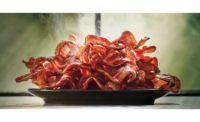Win Playing ‘the Sandwich Game’
By Cathy Sivak
Lure consumers with a consistent, quality approach to these supermarket-deli delicacies.
Add layers of existing supermarket deli and foodservice businesses to increased demand and it melds into hot growth potential for supermarket deli operations: sandwiches. Growth in the $103 billion sandwich category from 2003 to 2004 is expected to come in at 38 percent, and as one industry expert notes, “that’s tremendous.”
A supermarket deli serving up sandwiches can make it an art form that is also a traffic-driver. Individual markets currently support varying levels of supermarket sandwich sales, with programs ranging from full-fledged, made-to-order gourmet to a more mainstream approach with pre-made grab-and-go offerings. At either end, the sandwich market as a profitable, service-friendly supermarket store segment offers vast growth potential, industry experts tell The NATIONAL PROVISIONER.
One reason: Slightly less than 50 percent of consumers currently buy sandwiches at the supermarket level, relays “The Sandwich Study: Customer Attitudes, Buying Behavior, And Purchase Drivers,” a recent report from the International Dairy* Deli*Bakery Association (IDDBA).
This NP special report on the sandwich industry and its applications at the supermarket level is a collaboration of the IDDBA study and supporting information from industry experts and market observation.
Data in this special report is drawn from IDDBA’s The Sandwich Study. Data is largely based on IDDBA’s consumer panel of 1,126 polled via the Internet between April 14 and April 30, 2003; IDDBA retailer polling; and insight from NPD’s 52,500 consumers interviewed monthly. The Sandwich Study was initially presented at the association’s annual Dairy*Deli*Bakery event.
Sandwich consumption overview
Supermarkets have the opportunity to help increase sandwich consumption plus increase their share of the sandwich business, particularly if the quality, freshness, and value attributes of supermarket sandwiches is underscored.
There’s no doubt the sandwich is a popular meal choice for consumers, who average 4.1 sandwiches a week, including 2.8 sandwiches purchased ready to eat. The overall sandwich market shows 28 percent of consumers eating more total sandwiches than they did two years ago. The 18- to 29-year-old age bracket led growth, reporting a 38-percent increase in sandwich consumption.
Consumers are most likely to buy a sandwich at a fast-food outlet (88 percent), followed closely by sub/sandwich shops (85 percent). Less than half of consumers buy sandwiches from the supermarket deli (48 percent).
Cold sandwiches make up majority of sandwiches sold at the supermarket level, 86 percent, with hot sandwiches the remaining 14 percent of sales.
The supermarket channel holds a 7.4 percent share of overall restaurant traffic, but in supermarket sandwiches captures only 3.4 percent share. To boost deli sandwich consumption and increase their share of the overall sandwich business, it’s time for the supermarket channel to “get serious” about marketing sandwich programs, says Bill Bishop, retail and perishable industry consultant and recent presenter of “The Sandwich Experience: Selling the Sizzle” at the IDDBA show.
“Other sandwich sellers do a great job of marketing,” says Bishop, a principal of Willard Bishop Consulting Ltd., Barrington, IL. However, sandwich marketing does not receive high priority in the supermarket channel. Based on The Sandwich Study, consumer perceptions could be limiting supermarket deli sandwich sales, Bishop notes.
The top reasons consumers cited for not buying more supermarket deli sandwiches Bishop highlights include: not made fresh/pre-wrapped; too expensive/poor value; inconvenient; and don’t like/inferior taste.
At the same time, consumer awareness of supermarket sandwich programs is high: 73 percent of consumers report pre-made sandwich program availability at their local supermarket, and 54 percent make notice of made-to-order sandwich ordering capability. Meanwhile, three out of four consumers say the last sandwich they purchased was made-to-order (74 percent).
Nearly half of retailers consider their stores a destination location for sandwiches (46 percent). It fits with purchase habits, as most supermarket sandwich buyers are repeat customers, ringing up an average of 3.7 supermarket sandwich purchases monthly.
The characteristics of retailer sandwich programs vary, of course, by market and retailer. But many common factors are in play. For instance, more than half of retailers sell store- brand/private-label sandwiches (56 percent), and a quarter carry branded sandwiches (24 percent). Meanwhile, 28 percent of retailers feature a branded sandwich outlet or kiosk, and 5 percent of retailers tap into a franchise operation sandwich program.
Finding the right niche is key to sandwich marketing success. Sandwich retailing in the Minneapolis-St. Paul, MN, metro area is covered by the Lund’s and Byerly’s store banners. The two chains merged in 1997 under Edina, MN-based Lund Food Holdings Inc. and form a 20-store chain (12 Byerly’s, eight Lund’s) serving a quality-oriented, upscale customer base with a focus on high-quality foods and service.
Shoppers at Lunds and Byerly’s stores are pre-disposed to try new and upscale food items due to the store’s product mix, and the willingness carries over to sandwich sales, says Jennifer Panchenko, Lund Food Holdings’ vice president of foodservice. “Our delis are really about many, many food options for our customers,” Panchenko says. “It’s all about options to go, a restaurant without seats.”
What consumers want
Classic and upscale fillings, breads, and toppings are addressing the wide variety of consumer desires, and supermarkets are tapping into the trend. Cravings, quality/freshness, and bread types are the top-three purchase factors in play when sandwiches are purchased at the supermarket level.
Corresponding purchases in the fast-food channel are driven by cravings, price, and past experience, with bread type, cravings, and the option to get made-to-order top considerations to sub/sandwich shop purchases.
“Unfortunately, it doesn't look like most supermarkets are getting full credit for product quality, which, in many instances, is outstanding,” says Bishop.
Consumers do play flavor favorites. Nearly half of consumers (46 percent) switch purchases between a few preferred varieties of sandwiches, while 29 percent order the same type of sandwich every time. Meanwhile, some consumers seek variety, with 10 percent trying a new sandwich almost every time and another 11percent making a choice from the ‘specials’ list.
The types of sandwiches (excluding hamburgers) most popular across all channels vary slightly depending on the consumer and the region.
“As a retailer, you must know who your customer base is, who that shopper is, what the income level that clientele is, and what kind of food they like,” says Lou Hall, perishables expert for retail consultancy, The Partnering Group, Cincinnati, OH. “If I was a retailer in New York City city, pastrami would definitely be on the menu. But it would require evaluation on the menu in rural America.”
Men tend to consume 51.6 percent of all sandwiches purchased, while women consume 48.4 percent. Sandwiches with male-appeal include BBQ pork or beef; cold-cut combo; hot dogs; Reuben; fish sandwich; tuna salad; and steak sandwiches. Women are more likely to purchase sandwiches in varieties including bacon, lettuce, and tomato (BLT), chicken salad, grilled cheese, and turkey/turkey club.
When it comes to building the sandwich, roughly two-thirds of consumers tend to think of the fillings (meat/seafood/salad) first, bread second, cheese third, and sauces/spreads at the end. Consumers the most likely to think of fillings first are between the ages of 40 and 49 (72 percent), Caucasians (70 percent), and those earning $50,000 or more annually (73 to 75 percent). Roughly a quarter of consumers think about the fillings second (24 percent), with this group most likely to be made up of non-Caucasians (37 percent), and those earning less than $20,000 (30 percent).
The average supermarket deli/foodservice operation offers 15 standard sandwich varieties, with 28 percent of retailers offering even more.
A focus on fillings is underway, with bigger portions of meat the largest supermarket sandwich ingredient change made over the last two years by 34 percent of retailers. Meat fillings typically weigh in at 3.6-oz. per sandwich. The top-five selections include ham, turkey (non-specific), roast beef, salami, and turkey breast.
The top-five cheeses for sandwiches are Swiss, American, cheddar, provolone, and muenster, and the top-five selling breads are wheat, white, wraps, Kaiser rolls, and rye.
And when it comes to sandwich options, the Lunds/Byerly’s stores have it covered with 88 different sandwich recipes under the Classic line. Each store stocks a variety of up to 20 different types of sandwiches, from the Classic to cutting edge.
“A sandwich is great because it’s portable; people can grab it, eat, run. So for the busy consumer, it’s fabulous,” Panchenko says. “A lot of people who are in our store for sandwiches are running in on their lunch or dinner breaks from work.”
The chain’s delis are set up more like foodservice operations, with most carrying 20- to 24-linear feet of products, including entrées, fresh salads, and at least a 4- to 5-foot deck of sandwiches made fresh daily. Some stores feature sandwich shops, where customers-on-the-go can opt for made fresh to order or hot sandwiches, and eight others have cafes with seating. Still other stores offer a soup and sandwich bar offers with a choice of up to 24 types of hot (including griddle sandwiches like ham and cheese) or cold sandwiches.
In the Classic range, the chain’s top sellers are ‘salad’ sandwiches: egg, ham, chicken, and tuna. Each is made fresh daily with high-quality ingredients, including fresh bread, Hellmann’s mayonnaise, Greek lettuce.
In the cutting-edge range, the combinations meld higher-end tastes. Panchenko lists the ingredients of among her favorites, which she had just finished for lunch: pumpernickel bread, gruyere cheese from Switzerland, and very thinly sliced parmicotta ham from Italy. “It was delicious, so fresh, and the flavors together were just it was just a delight!”
For those tapping into low-carb marketing opportunities, sandwich wraps with inherent low-carb makeup can be cutting edge, Bishop says. He notes other new specialty trends in the market include heavy (and even exclusive) use of vegetables and cheese as sandwich fillings.
Merchandising is increasingly top-of-mind as retailers strive to showcase pre-made sandwich selections and offer attractive and functional packaging for made-to-order items. Presentation can also be a key to impulse buys.
“The retailer wants the sandwiches to be as visible as possible in many cases,” Joe Burns, senior marketing manager/deli for Perdue Farms Inc., Salisbury, Md. “While ninety-six percent of consumers say they want sandwiches prepared in front of them, that doesn’t mean they only buy sandwiches made in front of them — but they certainly prefer seeing presentation and quality.”
Perdue kicked off its Sandwich Advantage program in June 2004 at the IDDBA (International Dairy*Deli*Bakery) show. The program is designed to tap into category growth trends to help service deli customers capitalize sandwich category opportunities, Burns notes.
Poultry in traditional and bold flavors on exotic breads for supermarket deli application is featured in proprietary recipes designed by Perdue, including: classic Italian hero with a twist, barbeque grilled chicken wrap, smokehouse grilled turkey sandwich, Tuscan chicken panini, Virginia wrap, turkey pastrami, turkey cobb club, and chicken bacon Philly. “The range of recipes is designed to appeal to a wide demographic range, from the more traditional, to the more exotic,” Burns says.
Sandwich packaging at the retail level is likely to be cello/plastic wrap, utilized by 69 percent of retailers on about 58 percent of sandwiches sold. Other packaging used commonly includes a tray with overwrap; boxed; paper wrap only; and plated.
In support of its new Sandwich Advantage program, Perdue offers custom packaging and merchandising, including hinged lunch boxes, branded sandwich wrappers, clam shells, and labels that double as closures. Perdue also supplies nutrition information, as well as costing and suggested merchandising tools in a kit designed to be a fully comprehensive approach to helping retailers sell sandwiches.
At Lunds/Byerly’s, the customer can actually see the contents of popular classic sandwich pre-packages in wedge-shaped packaging, which allows a cut-in-half view and keeps out moisture and air to keep sandwiches fresh, Panchenko notes.
For more information on “The Sandwich Study: Customer Attitudes, Buying Behavior, And Purchase Drivers,” phone the International Dairy*Deli*Bakery Association at (608) 238-7908 or visit www.IDDBA.ORG
Cathy Sivak is a freelance writer based in Kenosha, WI.


Report Abusive Comment